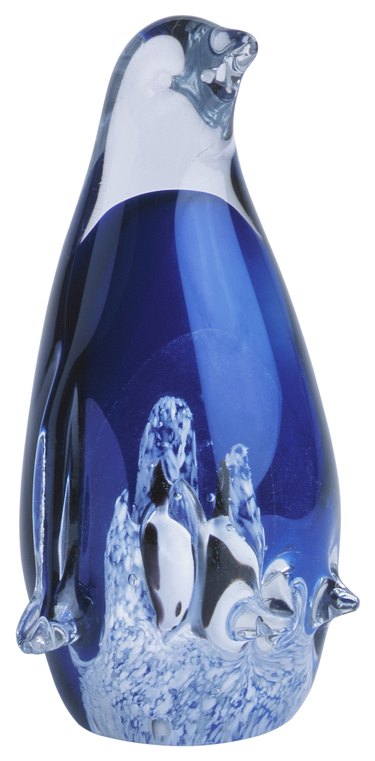
Glass blowing is an ancient art invented thousands of years ago that is still in practice today. Glass blowing cannot be done by machine and must be performed by a skilled artisan. Although modern manufacturers of glass bottles and other glass products use the same recipe for the glass material, they often use machines and molds to shape the glass instead of blowing the glass by hand. The level of skill and craftsmanship that goes into glass blowing makes it a more expensive and time-consuming process.
History
Video of the Day
The art of glass blowing originated in the Middle East about 2000 years ago, according to the book Glass. Glass blowing was invented when Middle Eastern glassmakers created a metal pipe they used to shape the glass. This technique created the clear, translucent glass that we have today. Up until then, glass was made primarily by grinding and casting glass materials which created an opaque pottery-like glass. Romans adopted the glassmaking technique and used it heavily in their expansive empire. The art of making glass came to the New World when Captain John Smith brought glassblowers from Europe to make glass in the Jamestown colony.
Video of the Day
Technique
The tools and glass-blowing technique used today are the same ones used thousands of years ago. Glass makers are known as gaffers. Gaffers use a recipe invented by ancient Egyptians to create the glass material, according to the Cornell Center for Materials Research. This recipe includes lime, sand and soda ash. The ingredients are mixed together and heated until they liquify. The gaffer then inserts the end of a metal tube, known as a blowpipe, into the hot liquid glass and twists it around so the glass gathers on the end. The gaffer blows into the tube and creates a glass bubble. The bubble is shaped into a vase, sculpture or bowl and allowed to cool and solidify.
Uses
Besides bowls and water containers, Romans also used their glass-blowing technique to make glass windows by cutting and flattening a long piece of blown glass. Remnants of glass windows have been found in the ancient Roman town of Pompeii, according to the book Glass. Roman glass windows eventually inspired Europeans to use glass-blowing techniques to create brightly-colored stained glass windows in churches, cathedrals and castles during the Renaissance period. Due to the expense, skill and time involved in making hand-blown glass, most hand-blown glass made today is used in expensive lamps, chandeliers, glass jewelry, vases and art.
Monopoly
Murano glass from Venice is one of the most well-known types of blown-glass. Glass makers in Venice held a monopoly on the blown-glass trade for centuries because of their secret glass-blowing techniques such as threading glass with strands of gold, making imitation gemstones out of glass and creating crystalline glass. In the year 1286, the doge of Venice moved the city's glass-making industry to the island of Murano to protect the secret Venetian glass-blowing techniques, according to the book One Hundred Greatest Scientific Inventions Of All Time. Eventually other countries developed newer glass-blowing techniques which ended the Murano monopoly.
- One Hundred Greatest Science Inventions of All Time; Kendall F. Haven; 2006
- Europe For Visitors: Murano, The Glass Island
- Glass: a World History; Alan Macfarlane; Gerry Martin; 2002
- Cornell Center for Materials Research: Glass-Making Process Has Evolved
- Heilbrunn Timeline of Art History: Roman Glass